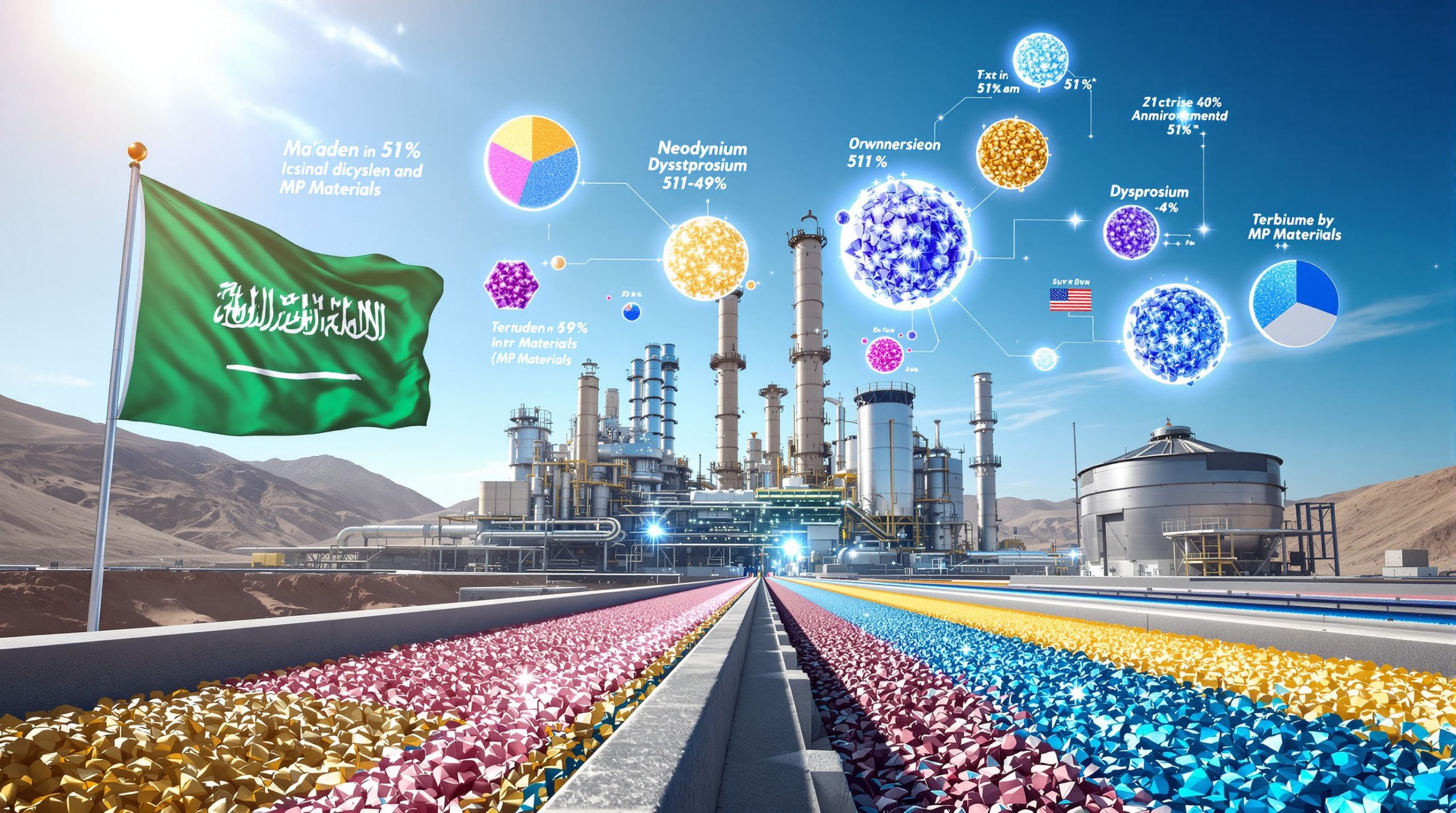Understanding Rare Earth Elements and Their Strategic Importance
Rare earth elements (REEs) constitute a group of 17 metallic elements that, despite their name, are relatively abundant in the Earth's crust. What makes them "rare" is not their scarcity but rather the difficulty in finding commercially viable concentrations and the complex extraction processes required to isolate them.
The strategic importance of rare earth elements cannot be overstated in today's technology-driven world. These elements serve as the bedrock of national security applications and defense technologies, from precision-guided missiles to radar systems and night vision equipment. They enable miniaturization of electronic components while enhancing performance capabilities critical for military advantages.
Beyond defense, REEs are essential components for economic competitiveness and technological advancement. Industries ranging from consumer electronics to medical devices rely on their unique properties to create smaller, lighter, and more efficient products. For instance, the smartphone in your pocket contains multiple rare earth elements, including neodymium for tiny speakers and europium for screen colors.
Perhaps most significantly, rare earth elements have become crucial materials for the clean energy transition. Wind turbines require large quantities of neodymium and dysprosium for their permanent magnets, while electric vehicles depend on these elements for motors and battery technology. According to industry experts, the average electric vehicle contains approximately 1-2 kg of rare earth elements, primarily in motor components.
This cross-cutting importance transcends political changes and administrations, cementing rare earths as strategic resources regardless of which party holds power in major economies.
Current State of the Global Rare Earth Supply Chain
The global rare earth supply chain faces a concerning geographic concentration. China dominates the sector, controlling 70-80% of mining operations and an even larger share of processing capabilities. This dominance didn't happen by accident—it represents decades of strategic investment and policy support by the Chinese government.
Demand for rare earth elements is projected to grow at approximately 9% annually over the next decade, driven primarily by renewable energy technologies and electric vehicle production. This growth trajectory places immense pressure on existing supply chains.
The vulnerability of this supply chain became evident in 2010 when China temporarily restricted rare earth exports to Japan during a territorial dispute, causing prices to skyrocket by over 600% for some elements. This incident served as a wake-up call for many nations regarding their dependence on a single source.
What makes diversification challenging is the capital-intensive nature of separation and processing. The journey from mining to production involves a complex, seven-step process that requires specialized knowledge and significant investment. Unlike many other mineral supply chains, rare earth processing cannot simply be relocated without overcoming substantial technical and financial hurdles.
Major Challenges in Diversifying the Rare Earth Supply Chain
Why Is China's Dominance Difficult to Challenge?
China's commanding position in the rare earth market represents 30-40 years of established infrastructure and expertise. Since the 1980s, when the United States transferred much of its rare earth processing knowledge to China, the country has systematically built its capabilities while Western nations reduced their involvement.
A key advantage China maintains is its control of specialized knowledge in separation techniques. The process of separating individual rare earth elements from one another—each with similar chemical properties—requires advanced technical expertise that has become concentrated within Chinese companies and research institutions.
Cost advantages through scale and government support further cement this dominance. Chinese rare earth facilities operate at scales that enable economies impossible to match with new operations. Additionally, reduced environmental compliance costs and direct government subsidies create price points difficult for Western competitors to match.
The geographical concentration of resources in key mining regions like Inner Mongolia gives China natural advantages. The Bayan Obo mine alone accounts for approximately 40% of global light rare earth element production, providing China with a substantial resource base.
History shows China's willingness to use rare earths as geopolitical leverage, as demonstrated in the 2010 dispute with Japan. This historical precedent concerns policymakers and companies contemplating investment in alternative supply chains.
What Makes Investment in Non-Chinese Supply Difficult?
The capital intensity of developing alternative supply chains presents a formidable barrier. Building separation facilities requires billions of dollars in upfront investment—a daunting sum for a market with annual revenues of approximately $8-10 billion globally.
This creates high financial risk relative to market size. Investors face the prospect of committing capital to projects with uncertain returns, especially when Chinese suppliers can potentially lower prices to undercut new entrants.
The knowledge gap in processing technology further complicates matters. Many Western companies have lost the technical expertise needed for efficient rare earth separation through decades of disinvestment. Rebuilding this knowledge base takes time and significant resources.
Price volatility represents another obstacle. Rare earth prices can fluctuate dramatically based on Chinese export policies or speculation, making long-term financial modeling challenging for new projects.
The limited investor appetite for mining compared to other sectors compounds these challenges. While technology or renewable energy companies attract abundant capital, mining ventures struggle to generate similar enthusiasm despite their critical role in supplying materials for these growth industries.
Emerging Opportunities for Supply Chain Diversification
How Can Saudi Arabia Transform the Rare Earth Landscape?
Saudi Arabia has emerged as a potential game-changer in the future of rare earth supply chain. Its strategic geographical position between Eastern and Western markets provides natural advantages for becoming a processing hub serving multiple markets.
The Kingdom offers competitive advantages including low-cost energy and feedstock—critical factors in rare earth processing economics. With some of the world's lowest electricity costs and abundant natural gas for chemical processes, Saudi Arabia could potentially process rare earth concentrates at costs approaching Chinese levels.
Recent exploration has revealed that Saudi Arabia possesses abundant rare earth resources, particularly in the Arabian Shield region. According to geological surveys, some deposits show concentrations comparable to major producing regions globally.
Modern mining laws and a regulatory framework designed to attract foreign investment further strengthen Saudi Arabia's position. The 2020 mining law overhaul specifically targeted streamlining processes for strategic minerals including rare earths.
Vision 2030, the Kingdom's long-term development strategy, explicitly identifies mining and mineral processing as priority sectors for economic diversification. This political stability and clear long-term vision reduce policy risk for potential investors.
Saudi Arabia's potential extends beyond mining to becoming a hub for downstream processing—potentially including magnet manufacturing and other high-value activities that currently remain concentrated in China.
What Role Can International Partnerships Play?
Emerging Australia-Saudi Arabia collaboration models demonstrate how international partnerships can overcome supply chain challenges. Companies like Hastings Technology Metals are exploring processing partnerships that leverage Australian mining with Saudi processing capabilities.
Government-to-government (G2G) cooperation frameworks provide policy support for these commercial arrangements. The recent memorandum of understanding between Australian and Saudi authorities specifically highlights rare earths as an area for strategic cooperation.
Cross-border knowledge and technology transfer becomes possible through these partnerships. Australian expertise in mining can combine with Saudi Arabia's growing processing capabilities, creating synergies impossible within single jurisdictions.
Combined capital deployment across multiple jurisdictions helps overcome the massive investment requirements. When partners from resource-rich nations join with manufacturing nations, they can distribute financial risks while securing entire supply chains.
Strategic alignment between resource-rich and manufacturing nations creates mutual interests in stable supply chains. Countries like Japan and South Korea, major manufacturers of high-tech goods, increasingly seek direct involvement in securing upstream rare earth supplies.
Government Support and Policy Interventions
What Government Measures Can Enable New Supply Chains?
Price floors or guaranteed offtake agreements represent powerful tools governments can deploy to derisk private investment. By ensuring minimum revenue levels, these mechanisms address the market volatility that deters investment.
Rather than direct subsidies, targeted financial incentives including tax benefits for rare earth processing can encourage private capital without creating market distortions or triggering trade disputes. These approaches have proven more sustainable in other strategic mineral contexts.
Development finance institutions backing projects in strategic locations can overcome the capital intensity barrier. Entities like the U.S. International Development Finance Corporation have begun directing capital toward rare earth projects in countries like Brazil and Australia.
Support for creating enabling ecosystems rather than individual projects multiplies impact. Investments in research centers, workforce development, and shared infrastructure benefit multiple ventures simultaneously, creating clustering effects seen in successful mining jurisdictions.
Regulatory stability and predictable investment environments may prove more valuable than financial incentives alone. Mining and processing facilities represent decade-long commitments that require confidence in stable operating conditions.
Defense-focused supply chain prioritization has emerged as a particularly effective approach. By securing military supply chains first, governments create anchor demand that can eventually support broader commercial applications.
How Are Western Governments Responding?
Western governments show increased recognition of rare earths' strategic importance compared to a decade ago. The issue has transitioned from academic concern to concrete policy action, with rare earths featuring prominently in critical minerals race strategies across the G7 nations.
Financial support for critical projects has materialized, exemplified by the $300 million in U.S. government funding to MP Materials for revitalizing domestic rare earth processing. This represents a scale of government involvement previously unseen in the sector.
The Development Finance Corporation has made investments in countries like Brazil specifically targeting rare earth development. These financial commitments reflect a recognition that purely private capital is insufficient given the strategic nature of these resources.
There's growing appetite to support projects in emerging jurisdictions with large deposits, including Vietnam, Brazil, and various African nations. Western governments increasingly recognize that domestic supply alone cannot meet demand, necessitating a network of friendly supplier nations.
Future Outlook and Timeline for Diversification
What Can We Expect in the Next 5-10 Years?
Alternative supply sources will emerge by the end of this decade, with projects currently in development phases expected to reach commercial production between 2025-2028. These include significant mines and processing facilities in Australia, the United States, and potentially Saudi Arabia.
China will remain dominant but with reduced market share, likely shifting from over 80% to approximately 65-70% of global rare earth reserves and processing capacity by 2030. This represents meaningful diversification without unrealistic expectations of Chinese displacement.
Pockets of Western supply will develop for specific applications, particularly in defense and critical technologies. Rather than complete supply chain replication, these will focus on high-value elements most crucial for strategic industries.
The trend will be selective derisking rather than complete decoupling from Chinese supply. Most commercial applications will continue utilizing Chinese materials, while strategic sectors establish parallel supply chains with higher costs but greater security.
Gradual knowledge transfer and technology development outside China will accelerate as more projects move toward production. This virtuous cycle of expertise development will reduce barriers for subsequent projects, potentially accelerating diversification in the 2030s.
What Will Drive Success in New Rare Earth Projects?
Projects must demonstrate commercial viability despite higher costs. Successful ventures will combine geological advantages with processing innovations to narrow the cost gap with Chinese suppliers, even if achieving complete cost parity remains unrealistic.
Strategic partnerships across the value chain from mining to end-users create stability. When automotive manufacturers or defense contractors directly invest in rare earth projects, they provide both capital and guaranteed demand.
Government backing to derisk investment through loan guarantees, tax incentives, or federal grants for minerals will remain essential for pioneering projects. The first generation of non-Chinese rare earth ventures will likely require significant government support to overcome initial barriers.
Vertical integration from mine to magnet where possible provides maximum value capture and supply chain control. Companies that control multiple steps in the process can better manage costs and quality while capturing profits across the value chain.
Successful projects will focus on specific high-value rare earth elements, particularly neodymium and praseodymium (NdPr), which represent approximately 80% of the market value despite being just two of seventeen rare earth elements.
FAQ: Rare Earth Supply Chain Development
Are rare earth elements actually rare?
Rare earth elements aren't rare in the Earth's crust, with cerium being approximately as abundant as copper. However, finding economically viable concentrations presents significant challenges. Unlike gold or copper, rare earths rarely form concentrated deposits, typically appearing as trace elements within other minerals.
The difficulty lies in the complex and costly processes required to separate them from other minerals and from each other. Their similar chemical properties make separation extremely challenging, requiring multiple chemical processes to achieve high purity levels needed for advanced applications.
Why can't Western companies simply compete with China on price?
China has developed infrastructure, expertise, and government support over 30-40 years, creating significant cost advantages. These include not only processing technology but also supply chain efficiencies, specialized equipment manufacturing, and a trained workforce difficult to replicate quickly.
China's ability to influence global pricing makes it difficult for new entrants to guarantee profitability. Historical precedent shows Chinese producers willing to lower prices temporarily to maintain market share, creating significant risk for new ventures with high capital costs.
Environmental and labor standards also create cost differentials difficult to overcome. Western operations must adhere to stricter regulations regarding waste management and worker safety, increasing operational expenses compared to some Chinese facilities.
What makes rare earth processing so capital intensive?
The separation process requires specialized facilities costing billions of dollars. A commercial-scale separation plant capable of processing 20,000 tons annually typically requires investment exceeding $1 billion before producing any revenue.
Specialized knowledge in chemical engineering and metallurgy remains concentrated in few companies globally. The processes involve precise control of temperature, pH, and numerous other variables that require extensive experience to master.
Complex chemical processes using significant quantities of acids, bases, and organic compounds necessitate specialized equipment resistant to corrosion and capable of precise control. These custom-designed systems cannot be readily purchased "off the shelf."
The industry's relatively small size compared to the investment required creates significant financial risk. The global rare earth market generates approximately $8-10 billion annually, yet individual processing facilities may cost $1-2 billion to construct.
How is Saudi Arabia positioning itself in the rare earth market?
Saudi Arabia is leveraging its low-cost energy and strategic location between Asian and European markets. With electricity costs approximately 30-40% lower than in Western nations and abundant natural gas for processing, the Kingdom offers natural advantages for this energy-intensive industry.
The country's Vision 2030 framework explicitly targets mining and mineral processing for economic diversification beyond petroleum. Recent discoveries of rare earth deposits in the Arabian Shield region have accelerated interest in developing a complete value chain.
Saudi Arabia aims to become a hub for downstream processing while supporting its own growing industries in electric vehicles and renewable energy. Recent partnerships with Australian mining companies demonstrate this hub strategy, with Saudi facilities potentially processing concentrates from multiple countries.
Furthermore, Saudi Arabia is hosting the Future Minerals Forum which has emerged as a platform for discussing innovative approaches to rare earth supply chain development.
Will China continue to dominate the rare earth market?
Yes, China will remain the dominant player for decades due to established infrastructure and expertise. Even optimistic diversification scenarios suggest China will maintain at least 60% market share through 2030.
However, alternative supply sources are expected to emerge by the end of this decade, reducing dependencies for critical applications. Projects in Australia, the United States, and potentially Saudi Arabia will create meaningful alternative supply chains, particularly for high-value elements like neodymium and dysprosium.
The goal is not to replace China but to create alternative supply options that reduce vulnerability to supply disruptions. This "China plus one" approach focuses on securing strategic elements for critical applications while acknowledging China's continued market leadership for commercial applications.
As the world faces increasing critical mineral shortages, particularly for technology that underpins the clean energy transition, the future of rare earth supply chain will increasingly depend on international cooperation and strategic resource planning.
Ready to Discover the Next Rare Earth Breakthrough?
Stay ahead in the high-stakes world of rare earth elements with Discovery Alert's real-time updates on significant ASX mineral discoveries. Visit our discoveries page for historic insights and start your 30-day free trial to gain a strategic advantage, powered by our proprietary Discovery IQ model.




